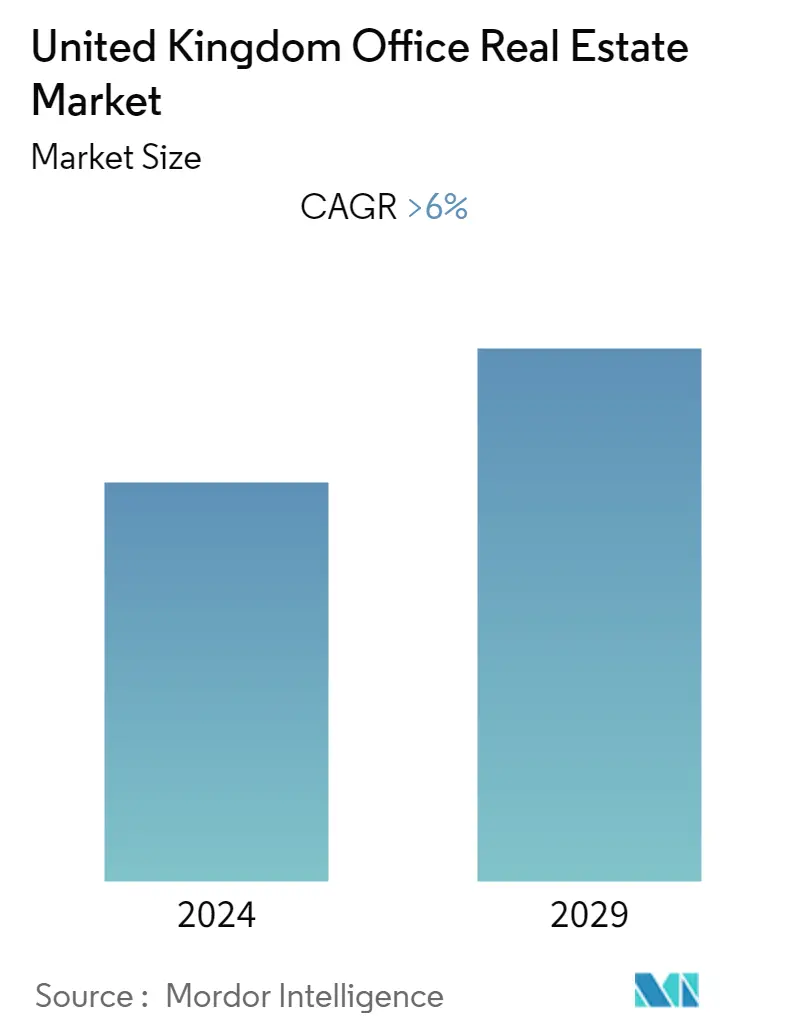Market Size of United Kingdom Office Real Estate Industry

| Study Period | 2019 - 2029 |
| Base Year For Estimation | 2023 |
| Forecast Data Period | 2024 - 2029 |
| Historical Data Period | 2019 - 2022 |
| CAGR | > 6.00 % |
| Market Concentration | Low |
Major Players
*Disclaimer: Major Players sorted in no particular order |
UK Office Real Estate Market Analysis
The Office Real Estate Market in the United Kingdom is expected to register a CAGR of more than 6% during the forecast period.
- The recent improvement in economic data and the subsequent reopening of the economy have improved the outlook for the office real estate sector.Leasing momentum is back as most offices are safely implementing return-to-work. Inquiries have picked up around city centers, and so has the leasing activity. The IT and ITeS sectors are among the prime drivers of overall leasing activity in the top cities, and bulk hiring by these firms will influence demand for large, quality office spaces.
- COVID-19 had a mixed impact on the office real estate market in the United Kingdom, including its services. Real estate was badly hit by the COVID-19 pandemic, with a sharp decline in values across all markets and sectors. The office real estate take-up was below normal due to the flexibility given to employees (working from home) by the companies. The lockdown measures have forced millions of people to work from home, and on the other hand, the short-term nature of contracts has left offices with very low occupancy across the United Kingdom.
- The uncertainty surrounding Brexit had already eroded confidence in the United Kingdom office property market. Although Brexit has been sharply put into perspective, leaving the European Union has not helped the United Kingdom address severe labor and material shortages as well as crippling supply chain issues. Since the pandemic began, occupants, for example, have been increasingly renewing their office spaces. Occupants are looking to be in new-generation offices with modern amenities and a focus on health and wellness.
UK Office Real Estate Industry Segmentation
Office real estate is the business of building buildings that companies from different industries can rent or buy.This report offers a complete analysis of the United Kingdom office real estate market, including a market overview, market size estimation for key segments, emerging trends by segments, and market dynamics. The report also offers the impact of COVID-19 on the market.
The United Kingdom office real estate market is segmented by key cities (London, Birmingham, Manchester, and Other Cities). The report offers market size and forecasts in dollars (USD billion) for all the above segments.
| By Key Cities | |
| London | |
| Birmingham | |
| Manchester | |
| Other Cities |
United Kingdom Office Real Estate Market Size Summary
The UK office real estate market is experiencing a resurgence, driven by the recovery from the COVID-19 pandemic and the reopening of the economy. The sector is witnessing a renewed leasing momentum, particularly in city centers, as companies implement return-to-work strategies. The IT and ITeS sectors are significant contributors to this demand, with bulk hiring necessitating large, quality office spaces. Despite the challenges posed by the pandemic, such as low occupancy rates and the shift to remote work, the market is adapting with a focus on modern amenities and health-conscious designs. The impact of Brexit has also been a factor, with labor and material shortages affecting the market, but confidence is gradually returning as companies commit to long-term leases in new-generation offices.
The Greater London and South East regions have seen a notable increase in demand, with significant transactional activity indicating a recovery. Large companies like Unilever and ITV have bolstered market confidence by securing substantial office spaces. While the office sector traditionally dominated commercial property investments, there has been a shift towards industrial real estate, driven by the growth of eCommerce and supply chain management. The UK office real estate market remains competitive and fragmented, attracting both domestic and international investors. Companies are leveraging strategic collaborations to enhance market share and profitability, with initiatives like activity-based office models and sustainable practices, such as the installation of electric vehicle chargers, reflecting a broader trend towards flexible and environmentally friendly workspaces.
United Kingdom Office Real Estate Market Size - Table of Contents
-
1. MARKET INSIGHTS AND DYNAMICS
-
1.1 Market Overview
-
1.2 Market Dynamics
-
1.2.1 Market Drivers
-
1.2.2 Market Restraints
-
1.2.3 Market Opportunities
-
-
1.3 Technological Innovations in the Office Real Estate Market
-
1.4 Government Regulations and Initiatives in the Industry
-
1.5 Insights into Rental Yields in the Office Real Estate Segment
-
1.6 Insights into the Key Office Real Estate Industry Metrics (Supply, Rentals, Prices, Occupancy, Vacancy)
-
1.7 Insights into Office Real Estate Construction Costs
-
1.8 Insights into Office Real Estate Investment in the United Kingdom
-
1.9 Porter's Five Forces Analysis
-
1.9.1 Bargaining Power of Suppliers
-
1.9.2 Bargaining Power of Consumers/Buyers
-
1.9.3 Threat of New Entrants
-
1.9.4 Threat of Substitute Products
-
1.9.5 Intensity of Competitive Rivalry
-
-
1.10 Impact of COVID-19 on the Market
-
-
2. MARKET SEGMENTATION
-
2.1 By Key Cities
-
2.1.1 London
-
2.1.2 Birmingham
-
2.1.3 Manchester
-
2.1.4 Other Cities
-
-
United Kingdom Office Real Estate Market Size FAQs
What is the current United Kingdom Office Real Estate Market size?
The United Kingdom Office Real Estate Market is projected to register a CAGR of greater than 6% during the forecast period (2024-2029)
Who are the key players in United Kingdom Office Real Estate Market?
Kajima Estates, Hines, LBS Properties, JLL UK and Knight Frank are the major companies operating in the United Kingdom Office Real Estate Market.

